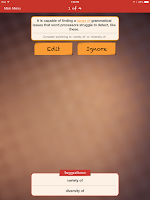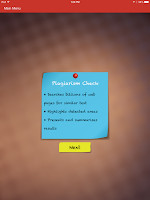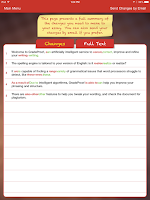 |
| Citation |
Students have now begun the editing stage of their stories. I have noticed that students are having many issues with grammar and spelling. The directions from the teacher say that students will have at least one peer edit their work before a teacher will look at it. As student work is coming to me, I have noticed that while students are doing a good job at editing the story for clarity and flow, they are having difficulty with fixing or even noticing grammar and spelling errors. Much to my surprise students were unfamiliar with spell check on word and did not know what it meant when a red or blue squiggly line was under a word.
If I were planning the lessons for this class I would spend a few days on learning about grammar and understanding the tools that help with editing on Microsoft word. I assume that the reason grammar and spelling is not emphasized in school is due to lack of time. Due to the lack of time for teaching grammar and editing, I found a great iPad app that will walk students through changes that can be made in their stories.
Grade Proof is a free app and website that can help students edit their work as well as check for plagiarism. By having students use Grade Proof first, editing by the teacher can turn into helping students work on and discuss the content of their story instead of having to mark through all of the errors.
To use Grade Proof, students sign up with an email address to create their account. Students then upload their text and begin with the editing process.
 Grade Proof first helps with spelling and grammar mistakes. The entire piece is read over and the app will notify you with the total number of errors. Students are then able to go through the errors one by one to see the mistakes. The great thing about Grade Proof is that it is not only correcting the mistakes, it will explain why it believes the piece needs to be edited so the students are still getting to learn the grammar basics. Students are then able to choose whether they want to edit the error or ignore it. It is important to explain to students beforehand that computers make mistakes and that they do not understand dialects or intentional spelling errors so students need to actually look at what is trying to be changed. Grade Proof has the user make the change either by typing it in or selecting it from the suggestions. So unlike sell check on a computer, students can just mindlessly click accept change.
Grade Proof first helps with spelling and grammar mistakes. The entire piece is read over and the app will notify you with the total number of errors. Students are then able to go through the errors one by one to see the mistakes. The great thing about Grade Proof is that it is not only correcting the mistakes, it will explain why it believes the piece needs to be edited so the students are still getting to learn the grammar basics. Students are then able to choose whether they want to edit the error or ignore it. It is important to explain to students beforehand that computers make mistakes and that they do not understand dialects or intentional spelling errors so students need to actually look at what is trying to be changed. Grade Proof has the user make the change either by typing it in or selecting it from the suggestions. So unlike sell check on a computer, students can just mindlessly click accept change. 
 The next step that Grade Proof goes through is 'Rephrase It' this looks at sentence structure and more complex grammar concepts. Students then select their goal for their writing which is to improve their writing. The piece is then analyzed again and students select if they want to change the wording to one of the suggestions or ignore it.
The next step that Grade Proof goes through is 'Rephrase It' this looks at sentence structure and more complex grammar concepts. Students then select their goal for their writing which is to improve their writing. The piece is then analyzed again and students select if they want to change the wording to one of the suggestions or ignore it.
The next step is 'Reword It'. I found this very helpful as I noticed that often the students are not using words in the correct context or the word they choose does not mean what they think it does. Grade Proof will go through the sentences and pick words that it thinks need to be changed to better the writing. Students again look through the suggestions and decide if they want to change the word.
 The final step is a plagiarism check which is extremely beneficial for teachers. Plagiarism checks can be extremely expensive but with Grade Proof, students can run the check and send the screenshot to their teacher for free! The changes to the piece can then be sent by email in a document.
The final step is a plagiarism check which is extremely beneficial for teachers. Plagiarism checks can be extremely expensive but with Grade Proof, students can run the check and send the screenshot to their teacher for free! The changes to the piece can then be sent by email in a document. Grade Proof allows for a redefinition of the lesson. Students are able to get the specific help they need in editing which will create time for the higher level analysis of their work by a teacher. It allows students to be independent and work through their papers at their own pace while still learning about grammar rules and how to improve their writing.
Grade Proof allows for a redefinition of the lesson. Students are able to get the specific help they need in editing which will create time for the higher level analysis of their work by a teacher. It allows students to be independent and work through their papers at their own pace while still learning about grammar rules and how to improve their writing. 




No comments:
Post a Comment